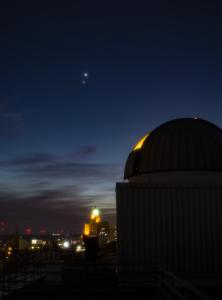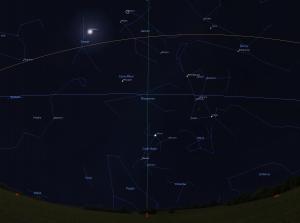Celebration of Space - March 03, 2023
On Tuesday, March 7, 2023, at 7:43 am ET the March Full Moon will occur. Carrying the moniker, the Full Worm Moon, this full Moon will be the last full lunar phase of winter. The Worm Moon gets its name from the wet conditions that persist during this time of the year. As we enter the muddy season in New England, which results from the thawing of the winter landscape, beetle larva will start to emerge from their wintertime abodes. Additionally, you may notice that there are worms present along your driveway and walkways as wet conditions persist. This year in Southern New England, it has been quite warm, and a thaw will likely not be a big deal. But it is certainly not any dryer than usual and the wet conditions are certainly present. So take a moment on Tuesday, right around sunset, to step outside and look to the east horizon to catch the Full Worm Moon of March rising, and welcome the last full Moon of winter 2022-2023
Over the past couple of weeks, Jupiter and Venus have been putting on a stunning dance in the evening twilight western sky. At times the crescent Moon has joined in the party, stepping up the view to fabulous. On Wednesday, March 1, 2023, the conjunction came to a climax when Jupiter and Venus appeared 0.5° apart in the evening sky. Even though we are past the height of the conjunction, Jupiter and Venus will continue to put on a show for the next week as they slowly move apart. Step outside each evening this weekend and coming week, right around 7:00 pm and look to the west. Jupiter will be situated below Venus in the sky. Venus is noticeably brighter than Jupiter, and is often mistaken for a plane due to its excessive brightness. Check out this stunning image of the conjunction captured by Brown University’s Bob Horton on Thursday, March 2, 2023 over Providence, Rhode Island.
After a bit of a lull in evening satellite passes over the US, China’s space station – Tiangong, will return to the evening sky on Tuesday, March 7, 2023, offering stunning views of the station passing over. Tiangong is a modular station, which has been increasing in size rather quickly. Currently not as bright as the International Space Station (ISS), Tiangong is growing close to its brightness. Even though we have had rather cloudy viewing conditions this year in Southern New England, there are several upcoming opportunities to catch a view of Tiangong passing overhead. Here is a list of worthy viewing opportunities starting this coming Wednesday:
Wed, Mar 8 at 7:16 pm, starting in the SW, rising to 25°, and into orbital sunset
Thu, Mar 9 at 6:16 pm, starting in the SSW, rising to 17°, heading towards the ESE
Thu, Mar 9 at 7:52 pm, starting in the WSW, rising to 21°, and into orbital sunset
Tiangong will continue to offer evening viewing opportunities through March 21, 2023, with some amazing passes happening in a week’s time. Note that these pass times are applicable for Southern New England, and are generally acceptable for any region in the Northeast. For daily pass times of brighter satellites, visit the Frosty Drew Daily Satellite Prediction tool.
Star of the Week: Castor
The bright star Castor is one of the brightest stars in the constellation Gemini. It resides at about 52 light years distant, and is a multiple star system comprised of six stars. But a telescopic observation will show this as only two stars. The two brightest stars of the Castor system are listed as A-class stars that are on the main sequence. This means that the stars are hotter and brighter than the Sun, will appear as white, and are currently in the same stage of activity as the Sun, fusing hydrogen to helium in its core. Castor is listed as Alpha-Gemini, which would imply that it is the brightest star in the Gemini constellation, though Pollux, Castor’s twin, is in fact slightly brighter. Observing Castor in the evening sky is easy, and should be possible from most locations outside of maybe Times Square NYC. Step outside around 8:00 pm and face the south. Look up nearly 80° and you will spot the constellation Gemini. This constellation is quite noticeable using the bright stars Castor and Pollux as they will appear quite close to each other with nearly the same brightness, but Pollux will appear a bit more red. Castor will be higher in the sky than Pollux. Here is a chart to help find Castor in the evening sky, around 8:00 pm, this week.
Starting this week, we will be showcasing a different star every Friday. The stars we showcase will not always be the brightest star visible, but we will attempt to stick to stars that are close to the Meridian near the end of the evening twilight. The Meridian is the imaginary line that runs from the north – south and separates the east and west sky. We will usually accompany the piece with a finder chart to assist in identifying the star. So keep looking up.
- Author:
- Scott MacNeill
- Entry Date:
- Mar 3, 2023
- Published Under:
- Scott MacNeill's Columns




